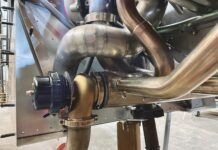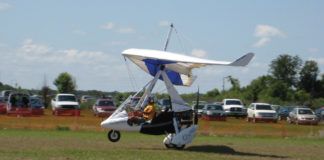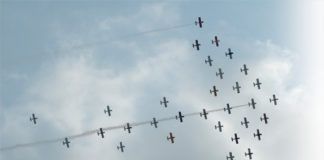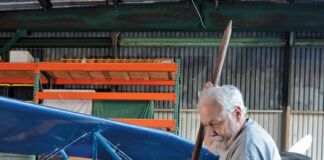Multi-tasking is a fairly new concept to the world, most likely born when the first computer geeks figured out how to have more than one task window open and running at the same time. Until then, we mostly expected to undertake one chore to completion, and then move on to the next item. Indeed, life was simpler before the first computer Graphical User Interface (GUI) window, often pronounced “gooey.”
Somewhere along the way, I think we’ve succumbed to the belief that people should be multi-tasking as well, just like our computers. When applied to an aircraft construction project (such as the subject of this series), the effects of personal multi-tasking have both positive and negative implications, all liberally seasoned with a full range of joy and angst.
Even with a capable team on hand providing the lion’s share of the expertise, a staggering number of details and minor tasks remained for the multitasking builder to perform, all needing timely resolution to prevent any single item from stopping the project cold. At certain times, I could swear I heard the voice of Mr. Spock from the original Star Trek series muttering the single word “fascinating” while observing my occasionally gooey progress in the hangar. Or maybe I just needed a bit more sleep between build sessions to keep all those plates successfully spinning on their poles.
Go, Team!
The upside of working in a team environment is the concurrent and rapid progress of the project on several different levels, and the ability to easily “dry fit” various systems before sections are closed. The downside, for me anyway, was having a brain stuffed to overflowing with different tracking considerations and action items, some crucial. Throw in the goal of having the airplane completed and test-flown before the attendees to last November’s Corvair College showed up, and life around the hangar became very interesting in the fall of 2006. I wouldn’t have missed a single minute of it.
As a plane-building novice, I quickly became aware of my dependence upon the expertise of the rest of the team. As you may recall, I first chose to fly behind one of William Wynne’s (The Corvair Authority) highly modified Corvair automotive conversions, and then purchased a well-proven Zodiac 601 XL quickbuild kit to put behind the engine. The engine itself would be assembled by FlyCorvair.Com’s Kevin Fahy, and the airframe construction and initial est flying would be led by A&P John “Gus” Warren. This might seem like taking the easy way out of building your own airplane to some, but as it turned out, there really is no substitute for the accumulated experience of others when the unexpected rears its ugly head to a first-time builder.
Does This Look Right to You?
Another consideration was that we were working with the first quickbuild fuselage to be produced by Zenith Aircraft, so there was a bit more scrutiny of work that had been done by the factory. Sure enough, Warren found that the vertical stabilizer/rudder had a decided tilt to one side when it was first bolted into place. Armed with a measuring tape, a laser level and a plumb bob, he set out to find the cause.
“Taking a plumb bob up to the top of the rudder, you could see it was out quite a bit,” Warren said. “Aft er taking measurements at different points along the length of the fuselage and seeing to make sure they were all plumb and level, I found that the end of the fuselage had a slight twist to it.” A-ha! Eureka!
That twist was enough to displace the top of the rudder by almost a full inch, and after contacting Zenith, Warren found out what the probable cause might be. It was likely that the fuselage had been jostled during the factory construction process, and had shifted slightly during the installation of a couple of rudder mounting components. After taking some digital photos of the problem and emailing them to Zenith, replacement parts quickly showed up, along with an apology for the trouble.
There were some other minor discrepancies with the pre-constructed fuselage, but nothing really significant. There were a couple of quarter-size dents around blind rivets, caused by too much space between the outer skin and the underlying support structure. One of the top skins wasn’t cut quite straight, giving the forward edge a noticeably wavy appearance. One of the bottom skins was a couple of millimeters oversize, preventing the gear legs from dropping into the channel until some trimming was done. But these things aren’t showstoppers unless you have your heart set on building a grand champion. And if that’s where you’re headed, I’d suggest building much of the airframe yourself to ensure that it’s as immaculate as humanly possible. (Assuming, of course, you possess the skills to achieve immaculate construction.)
The silver lining around the occasional black cloud that floats by any aircraft project is how the kit manufacturer measures up in terms of post-sale support. Any company can provide acceptable customer service when there are no issues to be resolved, but the real test is what happens when something isn’t right. The few times we had an issue with the kit, both real and imagined, Zenith responded quickly and with genuine concern. I only wish that other companies that have sold big-ticket items to me in the past had a similar customer service philosophy. I’d probably have lower blood pressure.
Besides seeing firsthand how Zenith responds under fire, I also learned a basic truth that would stay in the back of my mind during the rest of the construction process: When building an airplane, absolutely nothing can be taken for granted. When I thought I could get away with ignoring this particular lesson, the kit’s forward progress would soon come to a full stop.
Investing in “Real Estate”
One of the more enjoyable tasks at hand was to decide on an appropriate complement of avionics and instrumentation with which to decorate the cockpit, and then to figure out exactly where each item would reside. Given the simple nature of the airplane, I wanted a panel that had most of the comforts of an IFR aircraft but in as small a space as possible. I would put the permanent items in the center of the panel, leaving “real estate” open on the sides for future experimentation.
I also wanted comprehensive engine data, so a capable engine monitor system would be required. Given the Corvair engine installation, the engine monitor would most likely require a bit of tweaking to display exactly what was needed beyond what was typical with a “normal” aircraft engine. And because the Corvair uses dual, electrically driven fuel pumps, I wanted a stone-simple, proven and reliable way to keep track of how many and which way the electrons were flowing between the battery and alternator.
Aft er spending many hours on the phone, on the Internet and tromping around in the vendor hangars at AirVenture 2006, I had a plan. The communication duties would fall to a used Bendix/King KY197 radio found on eBay and a King KT76A transponder; an ACK A-30 encoder would let ATC know where and how high. An Ameri-King AK-450 ELT would get into the act, and tip off search and rescue as to where to find the wreckage, and maybe even the survivors.
The 2-inch VDO fuel gauges that come with the Zodiac kit were bigger than I wanted, so I decided to use the 1-inch, air-core analog gauges from UMA. These were small enough to mount in the center console right above the included fuel tank selector valve (from Andair in the U.K., very nice stuff). As I had just set a precedent with the UMA fuel gauges, I also ordered a matching UMA analog voltmeter and ammeter.
Not So Sacred Six
Frankly, there’s not a whole lot of space on the 601’s panel, but it’s typical of what’s available in most sport aircraft of a similar size. So I decided to purchase a Blue Mountain G4 EFIS to serve in place of the typical six-pack combination of altimeter, directional gyro, turn and bank, vertical speed indicator, artificial horizon, and airspeed indicator. Originally designed as a comprehensive backup instrument, it also features a virtual horizontal situation indicator (HSI) and a moving-map GPS with terrain indications. Best of all (for me, anyway), it occupies only a 4×4-inch square of panel space.
Because the G4 would be used as my primary flight instrument, it meant that switching to the other HSI or moving map functions would require flying by outside visual references only. In cruise flight, this really isn’t an issue, as long as you return to the primary EFIS screen in a timely fashion to confirm that your altitude and heading are still correct. To avoid continuous button-pushing to get both attitude and GPS navigation data, I used a big hunk of the available panel space, smack dab in front of the left seat, to install an AirGizmo dock to house my beloved AvMap EKP-IV portable GPS unit.
Having two separate and independent GPS systems in an otherwise simple aircraft may seem like overkill to most. But in reality, the combination of the two is a joy to fly, and provides a level of navigation redundancy that says I’ll really have to work hard to get lost in this airplane.
Round Peg, Square Hole
Given the roughly 4-inch-square footprint of the Blue Mountain system, and the dimensions of the King communications radio and transponder, installing these items with the most efficient use of panel space meant finding an engine monitor system that was about the same size as the Blue Mountain. The solution turned out to be the I-K Technologies AIM Lite, which fit the requirement almost perfectly.
However, the I-K engine monitor requires that a square hole be cut in the panel, adjacent to the standard 31/8-inch round instrument hole for the Blue Mountain unit. Initially, this doesn’t sound like a big deal, but cutting square panel holes does involve significantly more time and effort than simply using a standard size hole punch for everywhere a round instrument will go. Warren ended up cutting a lot of square holes in my cockpit, with only the Blue Mountain G4 and the four small UMA gauges mounted in the traditional round-hole fashion. (When I showed up with a square Hobbs meter toward the end of the project, you could hear his groan clear across the ramp.)
Another benefit of using the I-K system was the willingness of the company to modify the monitor to match the Corvair installation. This required reducing the number of EGT and CHT channels to two each. Because the exhaust headers and cylinder heads on this engine don’t encourage an individual EGT and CHT probe for each cylinder, one per side is sufficient. This frees up enough other data channels to monitor and display oil pressure, oil temperature, fuel pressure and tachometer indications through color-coded LED segments and a bright yellow digital display. The advantage of this dual indicator system became clear after the first few flights. A quick glance at the instrument face will confirm that all engine parameters are nominal once you get used to seeing the green bars in a certain position, and more detailed information can be pulled up by switching the digital display to monitor whatever engine parameter you wish.
No Frills? Not Exactly
As someone who indulges in a 3200+ nautical mile annual excursion to Oshkosh in a light airplane, I can attest to the boredom that can factor into any long cross-country flight. Considering that the cruise speed of the Zodiac 601 XL is in the 100-knot neighborhood when powered by a 100-horsepower engine, I suspected that any long flights of over several hundred miles might trend toward tedious at times. An intercom with a stereo music input would be just the ticket.
However, there really aren’t many affordable, two-place intercom units that also feature a stereo music input. One exception to this is the recently introduced Sigtronics Sport 200S, which has been designed specifically for the non-certified Experimental and ultralight categories. Weighing only 6 ounces with all of the jacks and hardware, which are included, the Sport measures a mere 1×2.5 inches. Given the small size and light weight, putting one in my Zodiac was a no-brainer. Because I now had a stereo-capable intercom, a good music source was next. Unlike some pilots I know, I just couldn’t justify the installation of a Sirius or XM satellite radio system in what was to be a simple airplane. Once again, the solution started with an AirGizmo docking system, the one designed to accept an iPod. And, again, it required a non-round hole. Sorry, Gus.
Fire Up and Go? Uh, No
While the various airframe components were uniting themselves into something that resembled a slick little airplane, the avionics and instrumentation were on a parallel course as the supporting cast. The engine had been finished early and successfully run for an initial break-in on the test stand, so we were all eager to see the sum of the individual parts coalesce into a proper airplane.
In hindsight, the quick-build airframe offered the fewest challenges—beyond the rudder/fuselage twist issue. One of these was the construction of the canopy, which seemed a bit complex when compared to the finished control surfaces and the ease of airframe assembly. Since this first fast-build kit was delivered to us, Zenithis now shipping the canopy assembly already built, which eliminates another time-consuming task.
However, a quick-build kit does absolutely nothing to streamline the balance of the project, such as installing the engine and its systems, or the avionics and instrumentation. It was in these areas that we ended up scratching our heads a few times, chasing down a variety of issues that seemed intent on preventing us from meeting first-flight goals. Persistence does pay off, however, and we’d come too far to be easily dissuaded from having the airplane flying by the first week of November. So we rolled up our sleeves, and tackled each issue with a variety of solutions and work-arounds.What else could we do?
Next month: some surprises while achieving true airworthiness.













